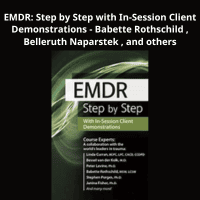Overview This U-Course offers a comprehensive and practical guide to integrating Eye Movement Desensitization and Reprocessing (EMDR) into your clinical practice. Designed for mental health professionals, the program focuses on developing essential clinical assessment skills, ensuring client safety and stabilization, and providing step-by-step instruction through powerful in-session client demonstrations. Learn to turn theory into effective, long-term trauma resolution for your clients.
Target Audience This course is ideal for mental health professionals, including but not limited to:
- Psychotherapists
- Counselors
- Social Workers
- Psychologists
- Therapists new to EMDR or seeking to deepen their existing knowledge.
Key Learning Objectives Upon completion of this course, participants will be able to:
- Identify Prerequisites for EMDR: Recognize essential conditions for trauma processing, including therapeutic alliance and client self-regulation skills.
- Assess Client Readiness: Evaluate client suitability and readiness for EMDR therapy.
- Understand Resource Development and Installation (RDI): Explain the theory behind “tapping in” client-driven imaginal resources.
- Create Internal Resources: Develop and demonstrate client-driven imagery for internal resource development.
- Implement Grounding Techniques: Demonstrate at least two effective grounding and centering techniques for traumatized clients.
- Define EMDR Fundamentals: Clearly define EMDR and its core components.
- Summarize Traumatic Memory Processing: Explain how EMDR is utilized for processing traumatic memories.
- List EMDR’s Eight Phases: Detail the eight phases of EMDR’s standard protocol.
- Apply Clinical Modifications: Explain the necessity and process of making clinical modifications to the standard protocol’s “script.”
- Understand Target Selection: Explain why initial traumatic memories are used as targets for EMDR.
- Discuss Precautions and Contraindications: Identify precautions and contraindications for EMDR use.
Core Content Areas The course provides a detailed breakdown of EMDR therapy, including:
- Introduction to EMDR: What EMDR is, its component parts, and its role in trauma treatment.
- Client Readiness and Preparation: Focus on assessing client readiness, establishing safety, and developing imaginal resources such as Comfortable Place, Nurturing Figure, Protector Figure, and Container.
- The Eight Phases of EMDR: A thorough exploration of each phase of the standard EMDR protocol.
- In-Session Demonstrations: Real-time footage and role-plays showcasing the application of EMDR techniques with clients.
- Clinical Modifications: Guidance on adapting the standard protocol for diverse client needs and complex trauma.
- Expert Commentary: Insights and support from renowned trauma leaders including Bessel A. van der Kolk, Peter Levine, Robin Shapiro, Babette Rothschild, and Belleruth Naparstek.
- Practical Strategies: Hands-on strategies for effective implementation of EMDR, including checklists and exercises.
Why This Course? This program is unique due to its emphasis on in-session client demonstrations and expert commentary, allowing you to see EMDR in action and understand the nuances of its application. It aims to provide the practical skills needed to safely and effectively utilize EMDR for long-term trauma resolution, transforming both your practice and your clients’ healing journeys.
Transform your practice and your clients' lives today! Enroll now to safely and effectively integrate EMDR into your clinical approach.
SIGN UP NOW







